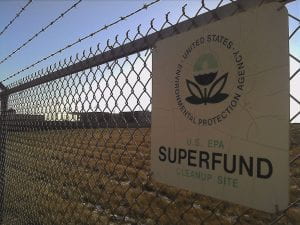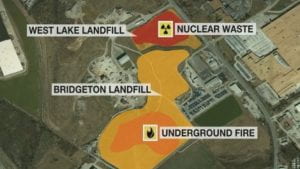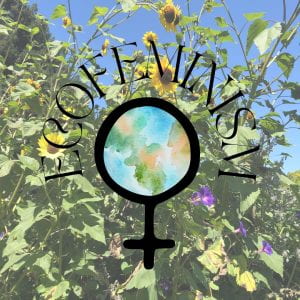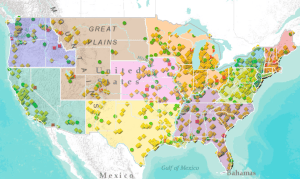It happened so many years ago, so it doesn’t affect us today, why does it matter? It’s not happening in my neighborhood so I’m safe. These are the very thoughts that run through individualistic minds as we tend to look past the stories we see in the media affecting other parts of the world. What if I told you that it is this very mindset that places patriarchy at the top? Would the next environmental issue plaguing society catch your attention and have you searching for ways to take action?

Let’s look at West Lake Landfill, a 200-acre site located in Bridgeton, Missouri, a designated Superfund site by the Environmental Protection Agency (EPA) since 1990. Now let’s break this down further. A “Superfund site” is a polluted location which is identified by the EPA as in need of specialized long-term clean up due to the presence of toxic and hazardous waste contaminants.
Now onto a brief history lesson on West Lake Landfill. During World War II, a St. Louis based company named, Mallinckrodt Chemical Works, manufactured uranium for nuclear weapons research to create atomic bombs for the Manhattan Project. The waste created in this process was then purchased by Cotter Corporation who then illegally dumped it in where we started, West Lake Landfill. Although the dumping took place in 1973, 50 years ago to be exact, the environmental and health impacts are not so distant.
In 2010, Republic Services, West Lake Landfill’s new owner, discovered an underground fire at the nearby Bridgeton Landfill, only 600 feet away from the radioactive waste site. Residents living nearby reported odd smells as a result

of the fire in addition to other health implications such as cancer and asthma. Despite all of the adverse effects that this site has presented, the area remains under the EPA and is only now being looked into for the extent of the waste.
Now you may be thinking, how does this all relate to ecofeminism? I’ll tell you why.
According to Hobgood-Oster’s, “Ecofeminism: Historic and International Evolution,” ecofeminism “…asserts that all forms of oppression are connected and that structures of oppression must be addressed in their totality. Oppression of the natural world and of women by patriarchal power structures must be examined together or neither can be confronted fully” (2005). Now what does this mean in simpler terms?
Let’s break it down into two components:

Environmentalism is the concern about the natural world, aimed at protecting the environment.
Feminism is the advocacy around women’s rights based on equality for all sexes whether it be socially, politically, or economically.
Now let’s connect the two to create ecofeminism, where both the degradation of the environment and the oppression of women are consequences of patriarchy and capitalism and therefore cannot be understood separately.
However, like most theories, there are criticisms and concerns to be aware of. As Hobgood-Oster describes, there is no one ecofeminist theory as stances change over time with location and “…because of this constant morphing, ecofeminism simultaneously challenges patriarchies from different angles” (2005). Therefore, it is crucial not to generalize ecofeminist theory and more importantly, we must be cautious of the binary that feminism seeks to diminish.
Ecofeminist perspectives may often correlate a strong connection between women and nature reinforcing essentialist perspectives. Essentialism being the belief that “…a particular race, gender or other category share the same traits” (Hobgood-Oster 2005). As ecofeminists we want to analyze how systems of patriarchy aid in the oppression of nature and women, but not assume that all women are the same.
Here’s an example of a connection between women and nature from the well-known animated movie, Moana.

Moana is set out on a cultural journey of identity when she recovers the lost heart of Te Fiti, the “giver of life.” The island is plagued by a curse through the evil spirit of the demigod, and it is the ocean who chooses Moana to restore life much like the history of masculine domination we read about in Hobgood-Oster’s ecofeminism piece. Moana holds a close connection with nature as the ocean guides her on her journey ultimately returning the heart to the goddess herself who can restore life. Here the creation of life is feminized insinuating that women hold a deep connection to nature while it is the male demigod who stripped it away. Not to mention, Te Fiti was depicted as coming back to life when adorned with full locks of greenery and colorful flowers on her head relating to the expectations of femininity with beauty, the flowers being nature’s beauty.
Circling back to the West Lake Landfill, let’s analyze this from an ecofeminist perspective. Corporations that are responsible for dumping the toxic waste as well as the delay in urgency to handle and contain the cleanup of contaminants is evidence that the binary of culture and nature exist. We live in a capitalist culture; it is all about maximizing profit. It was profitable for the Cotter Corporation to dump the uranium at the West Lake Landfill site, so they did.
Out of sight, out of mind, right? Ecofeminists say no!
If the binary exists, the disconnect between human and the environment becomes an “…integral component of societal structuring and justification, they will continue to serve as starting points to justify patriarchy” (Hobgood-Oster 2005). The domination of the environment directly intersects with the domination of life as we can see in this case.
There needs to be recognition that it is not simply men that are responsible for all oppression, but rather the androcentric perspective that holds male superiority at the center of society, marginalizing both femininity and nature together.
Deliberately dumping toxic waste asserts human control over the land and in turn marginalizes the community at the center of this. West Lake Landfill is situated in a suburb of St. Louis, which has one of the poorest zip codes making this area an appealing dumping ground as community residents hold less authority to stand up against major corporations. This becomes known as environmental racism, institutional racism that connects the oppression of the environment with issues of race and class (Hobgood-Oster 2005).
As women hold the responsibility of support and care for their families, mothers in the St. Louis community felt most impacted by the effects of the

illegal dumping. Children are getting cancer at elevated rates leading to mothers having to face chronic stress and health implications. The mothers in the community have created an activist group, Just Moms STL, where they demand answers and bring awareness to the issues impacting themselves and the community.
This is where environmentalism and feminism intersect. There is demand to clean up the contaminated land and calls for the voices of women in the community to be heard.
Now back to the question that this blog started with, it happened so many years ago so it doesn’t affect us today, why does it matter? It’s not happening in my neighborhood so I’m safe.
Well… it DOES matter, and it IS, and CAN happen in our own neighborhoods.

Practices and policies that structure our society are shaped by capitalism and patriarchy. And as far as toxic dumping, this happens in several locations across the nation! While severity ranges, there are Superfund sites everywhere. Take a look at the map to see where your state stands.
Now to leave you on a positive note, we can make a change! Bring statistics to local policy makers, create awareness groups, and educate the community. As Hobgood-Oster closes her piece with a powerful quote,
“Things will not just happen…Women must do something” (Gaard, ed.,3).

Hi Kylie,
What a great post!
The toxic waste dumped at West Lake Landfill site in Missouri is a great example of the consequences of prioritizing profit over the environment. It reminded me of a property I inquired about in early 2021 when I was on the market to purchase a home. The house, perfect for my family size, was on the Fall River, MA/Tiverton, RI line. Sadly, the property was on one of 50 lots in the neighborhood that had served as dumping ground for coal gasification waste, decades prior. Part of the remediation was a restriction that limited excavation to two feet on the property. I did some research and found that there was much more to it, and I did not purchase the property. This was another example of how issues that may have occurred years ago have devastating long-term health and environmental effects on us today. This is why adopting an individualistic mindset and ignoring environmental issues that don’t affect one’s immediate surroundings can reinforce the systems of patriarchy and capitalism that lead to environmental degradation. We must recognize the interconnectedness of environmental and social issues and take action to address them, even if they don’t affect us directly, because that is the only way we can help create a more sustainable and equitable world for future generations.
To read more about this issue, visit: https://dem.ri.gov/environmental-protection-bureau/land-revitalization-and-sustainable-materials-management/state-21
Hi Rose,
Thank you for your comment! It is important that you mention the connection between social issues and environmental ones as I touched upon in regards to the environmental racism happening in Missouri. Unfortunately, urban cities experience a disproportionately higher amount of this systemic racism as major corporations industrialize while policies do little to protect the land and the people who inhabit it, especially as they tend to be of lower socioeconomic status.
I’m glad you highlighted the contaminated soil in an area close to us. We may think dumping of hazardous material doesn’t happen near us, but unfortunately it does. I’m from Westport, MA and live only a town over from Fall River and Tiverton, Bay Street is only minutes away. I remember hearing about the soil contamination from the sewer plant but never knew the extent of this until I read more about it in the link that you shared, so thank you. As I was looking at the Superfund Site map I included in my blog, I realized that there is one right in North Dartmouth, MA, very close to the UMass Dartmouth campus. According to the EPA, the company, Re-Solve, Inc. handled a variety of hazardous materials including polychlorinated biphenyls (PCBs) which were then disposed into unlined lagoons and burned periodically, contaminating the soil and groundwater. The site still continues to be monitored and treated but this is another example of capitalism and patriarchy dominating the land which too oppresses the individuals in connection with it.
If you are interested in reading more about Re-Solve, Inc., here is the link to the EPA website: https://cumulis.epa.gov/supercpad/SiteProfiles/index.cfm?fuseaction=second.Cleanup&id=0100682#bkground
Best,
Kylie C.
Looking forward to reading this first post!
Thank you, Professor Gardner!
I recently had an excellent experience with Double Quick
Locksmith! They offered quick and professional services for
my car key replacement, and their car key programming was seamless.
I was in a bind when I got locked out of my car, but their car lockout service was a lifesaver!
Highly recommend them for commercial locksmith services too.
The mobile locksmith service made everything even more convenient!